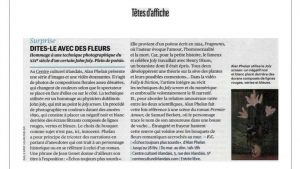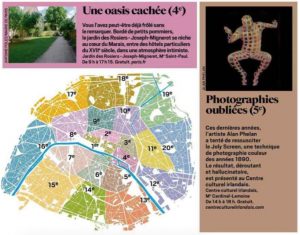ECHOS TOUJOURS PLUS SOURDS, 2021
Alan Phelan
Echos toujours plus sourds
7 Jan– 28 Feb 2021
Tues-Sun: 2pm-6pm
closed Mondays
(postponed from November 2020 due to Covid-19 lockdown restrictions on cultural institutions)
https://www.centreculturelirlandais.com/agenda/alan-phelan (French)
https://www.centreculturelirlandais.com/en/agenda/alan-phelan (English)
Review:
ALAN PHELAN, INSIDE THE FORGOTTEN ROOTS OF COLOUR
by Gilles Renault
January 21, 2021 at 5:31 PM
At the Irish Cultural Centre, the artist brings back to life, revisits and imagines the history that the “Joly Screen” never had, a colour photography process dead before its time, invented by a Dublin scientist in 1894.
Certain inventions transform everyday life to the point of triumphantly crossing the ages, while others just peter out into nothing. Like the “Joly Screen”, which a Parisian exhibition brings back to life, as part of the Photo Saint-Germain festival; which celebrates its ten years in within lockdown turmoil, through a good twenty or so events – Flore at the Academy of Fine Arts, Massao Mascaro and Jonathan Llense at the Crous gallery, Guy Le Querrec at the Libaririe des Alpes …
Let’s head then, to the Irish Cultural Centre, which honours two compatriots. The first, John Joly, who died in 1933, was a physicist and professor of geology. An ardent researcher (cf. some 250 publications signed in scientific journals), his interests lay mostly in the applications of radium, in the theory of cohesion-tension theory and (in his spare time?) he developed in 1894, the first process of colour photography on a single plate made up of red, green and blue lines, used in association with black and white film.
Florid Flourishes
Alas, we only remember the autochrome, an industrial technique patented nine years later by the Lumière brothers, but not the “Joly Screen”, which was quickly forgotten – the remnants of this first discovery, moreover, have turned into a fairly uniform magenta in subsequent decades.
This is where another factotum comes into play: no less than Dubliner Alan Phelan, a visual artist capable, between sculptures, films and performances, of working with both papier-mâché and fragrances, in a global approach questioning “the relationships between history, sexuality and politics”. A vast scheme of things, we agree, which led him to neatly re-invent Sherlock Holmes or Roger Casement (an Irish writer and revolutionary), as well as to borrow from Jean Genet the title of the present exhibition, “Echoes are always more muted”, found in his unfinished 1954 poem.
With a cobbler’s (or smuggler’s) eye for detail or what lies beneath Phelan captures the pictorial backstory that takes one outside the fixed time frame of the piece. Phelan imagines the “visual history” that the invention did not have time to have, through fifteen backlit photos, all in the same (small) format, which represent floral motifs (bouquets in vases, wreath of greenery) or the artist himself, although unrecognisable from behind, dressed in a sweater with geometric pattern, or from the front but with the face hidden behind a large plant leaf pierced with two holes at eye level. Even more convoluted, each work title mentions the personalities and events to which it refers, without, to be frank, being very obvious. Thus “Constance Spry(1) 1938, when the War of the Worlds broadcast invented Superman” or “Hans Memling 1490, when the prophetic extinction occurred”.
Moving wave
In addition to the photographs, a fifteen-minute experimental video completes the expedition, with a drum ‘n bass score designed by local musicians (Elaine Hoey, JRDN…). Green, red and blue vertical bands, more or less large and lively, streak the screen, superimposed on the filmed images where we can make out the sky, a city, branches, graves, or John Joly played by an actor, as well. than strafed words ( “Piled”, “Sore”, “Addiction” … ), this time leading the subject towards the moving wave of kinetic art of which, ipso facto , the “Joly Screen” would suggest a lineage as distant as subliminal, if not apocryphal.
(1) British author and florist.
Gilles Renault
Alan phelan
Echoes are ever more muted
Irish Cultural Centre, 75005,
free admission, until February 28.
CRITIQUE
ALAN PHELAN, DANS LES RACINES OUBLIÉES DE LA COULEUR
Par Gilles Renault
— 21 janvier 2021 à 17:31
Au Centre culturel irlandais, l’artiste ressuscite, revisite et imagine la postérité que n’a jamais eue le «Joly Screen», procédé mort-né de photographie couleur conçu par un chercheur dublinois en 1894.
Certaines inventions transfigurent le quotidien jusqu’à traverser triomphalement les époques, tandis que d’autres s’évanouissent dans les limbes. Tel le «Joly Screen», qu’une exposition parisienne revivifie, dans le cadre du festival Photo Saint-Germain ; lequel célèbre ses dix ans dans la tourmente sanitaire, à travers une bonne vingtaine de rendez-vous – Flore à l’Académie des Beaux-Arts, Massao Mascaro et Jonathan Llense à la galerie du Crous, Guy Le Querrec à la librairie des Alpes…
Direction, donc, le Centre culturel irlandais, qui met à l’honneur deux compatriotes. Disparu en 1933, le premier, John Joly, était physicien et professeur de géologie. Chercheur ardent (cf ses quelque 250 parutions signées dans des revues scientifiques), il s’intéressera notamment aux applications du radium, à la théorie de la tension-cohésion et (à ses heures perdues ?) mettra au point en 1894 le premier procédé de photographie couleur sur une plaque unique constituée de lignes rouges, vertes et bleues associées à un film noir et blanc.
Tarabiscoté
Las, on se souviendra de l’autochrome, technique industrielle brevetée neuf ans plus tard par les frères Lumière, mais pas du «Joly Screen», vite englouti – les traces de la trouvaille ayant, de surcroît, viré au fil des décennies au magenta assez uniforme.
C’est là qu’entre en scène un autre couteau suisse : le non moins Dublinois Alan Phelan, plasticien capable, entre sculptures, films et performances, de travailler aussi bien le papier mâché que les odeurs, dans une démarche globale questionnant «les rapports entre histoire, sexualité et politique». Vaste dessein, on en convient, qui l’amène à broder autour de Sherlock Holmes ou de Roger Casement (un écrivain et révolutionnaire irlandais), comme à emprunter à Jean Genet le titre de la présente expo, «Echos toujours plus sourds», trouvé dans son poème inachevé de 1954.
Ressemeleur (ou passeur) dans l’âme, Phelan imagine alors «l’histoire visuelle» que l’invention n’a pas eu le temps d’avoir, à travers quinze photos rétro éclairées, toutes au même (petit) format, qui représentent des motifs floraux (bouquets dans des vases, couronne de verdure) ou l’artiste lui-même, quoique méconnaissable puisque, ici de dos vêtu d’un pull aux motifs géométriques, là de face mais le visage caché derrière une grande feuille végétale juste percée de deux trous au niveau des yeux. Encore plus tarabiscoté, chaque titre d’œuvre mentionne les personnalités et événements auxquels elle se réfère, sans, pour être franc, que le rapport saute aux yeux. Ainsi de Constance Spry (1), 1938, quand la radiodiffusion de la “Guerre des mondes ” engendra “Superman” ; ou de Hans Memling, 1490, lorsque survint l’extinction prophétique.
Onde mouvante
En sus des photos, une vidéo expérimentale de quinze minutes boucle l’expédition, sur une partition de drum’n bass conçue par des musiciens du cru (Elaine Hoey, JRDN…). Des bandes verticales vertes, rouges et bleues plus ou moins larges et animées y strient l’écran, superposées aux images filmées où l’on distingue le ciel, une ville, la ramure, des tombes, ou John Joly joué par un acteur, ainsi que des mots mitraillés («Piled», «Sore», «Addiction»…), entraînant cette fois le propos vers l’onde mouvante de l’art cinétique dont, ipso facto, le «Joly Screen» suggérerait un lignage aussi lointain que subliminal, sinon apocryphe.
(1) Autrice et fleuriste britannique.
Gilles Renault
Alan Phelan
Échos toujours plus sourds
Centre culturel irlandais, 75005, entrée libre, jusqu’au 28 février.

